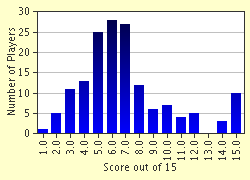Quiz Answer Key and Fun Facts
1. Although it has become traditional to perform "Hansel und Gretel" around Christmastime, this tradition only began late in the twentieth century.
2. In addition to "Hansel und Gretel", Humperdinck composed an operatic version of another favorite Brother's Grimm fairy-tale; which was it?
3. Humperdinck was greatly influenced by Richard Wagner, who had invited the younger composer to Bayreuth to assist in the preparation of what would be his final opera; what was the opera?
4. Upon completing the score of "Hansel und Gretel", Humperdinck presented the manuscript to this eminent German composer, who declared "This work is truly a masterpiece of the first rank." Who was the composer?
5. There are a number of differences between the libretto of Humperdinck's opera and the original story as recounted by the Brothers Grimm. Which of these is NOT one of them?
6. The role of the Witch has occasionally been performed by a tenor.
7. The roles of the Sandmannchen and the Taumannchen (the sand and dew fairies) are both scored for this voice type.
8. One major piece from the opera was not performed at the premiere in 1893; which was it?
9. The melody of the "Evening Prayer" (easily the best-known piece in the score) is quoted briefly in Act I. Gretel reminds Hansel, who is complaining bitterly of hunger, of a maxim they had been taught: "Wenn die Not aufs Hochste steigt, Gott der Herr die Hand uns reicht" ("When Need is at it's height, the Lord God stretches forth His hand"). From whom did the children learn this saying, which is quoted at the very end of the opera?
10. Collapsed in despair after the jug of milk she had put by to make supper is smashed, the children's mother Gertrud is still more embittered when her husband Peter arrives home, apparently in a state of inebriation. Her mood quickly changes to exultation, however, when he produces the makings of a feast: butter, eggs, bacon, sausage, turnips, onions, even a half pound of coffee! Peter proceeds to explain how he came by the means to buy these dainties; he had gone into town and made a large number of sales; what items did he sell?
11. The "Hexenritt" (Witches' Ride") describes the ride of numerous witches on their broomsticks and owes, perhaps, some inspiration to Wagner's celebrated "Ride of the Valkyries". Where in the opera is it performed?
12. While gathering berries in the wood, the children hear and imitate the distinctive call of this bird.
13. In the famous "Evening Prayer", the children call upon their guardian angels to watch over them as they sleep. According to the song, how many angels keep watch over each child?
14. In Act III, Hansel and Gretel encounter the Witch, who introduces herself by name. What is her name?
15. A broadcast performance of "Hansel und Gretel" inaugurated the tradition of live radio broadcasts from the stage of the Metropolitan Opera.
Source: Author
jouen58
This quiz was reviewed by FunTrivia editor
Bruyere before going online.
Any errors found in FunTrivia content are routinely corrected through our feedback system.

